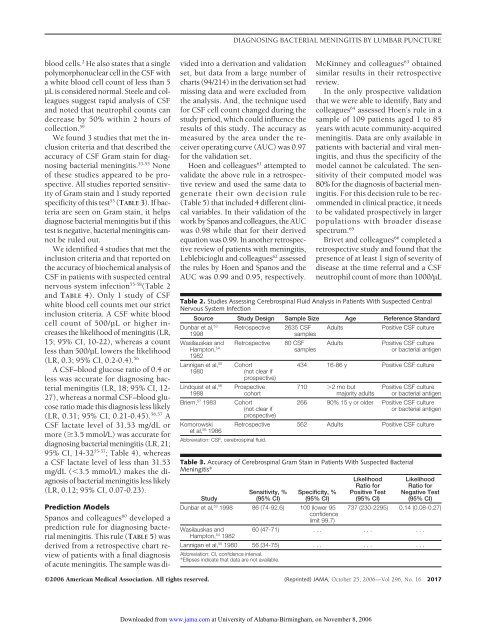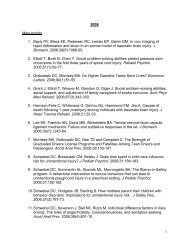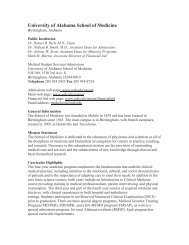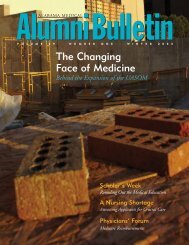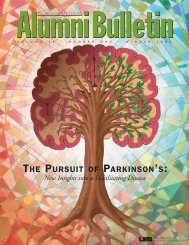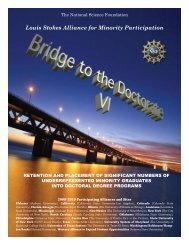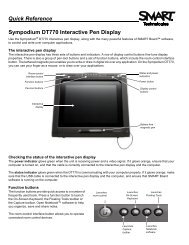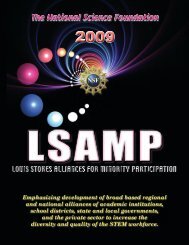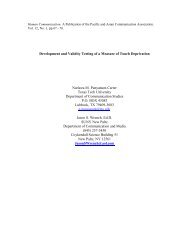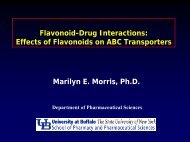How Do I Perform a Lumbar Puncture and Analyze the Results to ...
How Do I Perform a Lumbar Puncture and Analyze the Results to ...
How Do I Perform a Lumbar Puncture and Analyze the Results to ...
You also want an ePaper? Increase the reach of your titles
YUMPU automatically turns print PDFs into web optimized ePapers that Google loves.
DIAGNOSING BACTERIAL MENINGITIS BY LUMBAR PUNCTURE<br />
blood cells. 2 He also states that a single<br />
polymorphonuclear cell in <strong>the</strong> CSF with<br />
a white blood cell count of less than 5<br />
µL is considered normal. Steele <strong>and</strong> colleagues<br />
suggest rapid analysis of CSF<br />
<strong>and</strong> noted that neutrophil counts can<br />
decrease by 50% within 2 hours of<br />
collection. 59<br />
We found 3 studies that met <strong>the</strong> inclusion<br />
criteria <strong>and</strong> that described <strong>the</strong><br />
accuracy of CSF Gram stain for diagnosing<br />
bacterial meningitis. 53-55 None<br />
of <strong>the</strong>se studies appeared <strong>to</strong> be prospective.<br />
All studies reported sensitivity<br />
of Gram stain <strong>and</strong> 1 study reported<br />
specificity of this test 53 (TABLE 3). If bacteria<br />
are seen on Gram stain, it helps<br />
diagnose bacterial meningitis but if this<br />
test is negative, bacterial meningitis cannot<br />
be ruled out.<br />
We identified 4 studies that met <strong>the</strong><br />
inclusion criteria <strong>and</strong> that reported on<br />
<strong>the</strong> accuracy of biochemical analysis of<br />
CSF in patients with suspected central<br />
nervous system infection 55-58 (Table 2<br />
<strong>and</strong> TABLE 4). Only 1 study of CSF<br />
white blood cell counts met our strict<br />
inclusion criteria. A CSF white blood<br />
cell count of 500/µL or higher increases<br />
<strong>the</strong> likelihood of meningitis (LR,<br />
15; 95% CI, 10-22), whereas a count<br />
less than 500/µL lowers <strong>the</strong> likelihood<br />
(LR, 0.3; 95% CI, 0.2-0.4). 56<br />
A CSF–blood glucose ratio of 0.4 or<br />
less was accurate for diagnosing bacterial<br />
meningitis (LR, 18; 95% CI, 12-<br />
27), whereas a normal CSF–blood glucose<br />
ratio made this diagnosis less likely<br />
(LR, 0.31; 95% CI, 0.21-0.45). 56,57 A<br />
CSF lactate level of 31.53 mg/dL or<br />
more (3.5 mmol/L) was accurate for<br />
diagnosing bacterial meningitis (LR, 21;<br />
95% CI, 14-32 55-57 ; Table 4), whereas<br />
a CSF lactate level of less than 31.53<br />
mg/dL (3.5 mmol/L) makes <strong>the</strong> diagnosis<br />
of bacterial meningitis less likely<br />
(LR, 0.12; 95% CI, 0.07-0.23).<br />
Prediction Models<br />
Spanos <strong>and</strong> colleagues 60 developed a<br />
prediction rule for diagnosing bacterial<br />
meningitis. This rule (TABLE 5) was<br />
derived from a retrospective chart review<br />
of patients with a final diagnosis<br />
of acute meningitis. The sample was divided<br />
in<strong>to</strong> a derivation <strong>and</strong> validation<br />
set, but data from a large number of<br />
charts (94/214) in <strong>the</strong> derivation set had<br />
missing data <strong>and</strong> were excluded from<br />
<strong>the</strong> analysis. And, <strong>the</strong> technique used<br />
for CSF cell count changed during <strong>the</strong><br />
study period, which could influence <strong>the</strong><br />
results of this study. The accuracy as<br />
measured by <strong>the</strong> area under <strong>the</strong> receiver<br />
operating curve (AUC) was 0.97<br />
for <strong>the</strong> validation set.<br />
Hoen <strong>and</strong> colleagues 61 attempted <strong>to</strong><br />
validate <strong>the</strong> above rule in a retrospective<br />
review <strong>and</strong> used <strong>the</strong> same data <strong>to</strong><br />
generate <strong>the</strong>ir own decision rule<br />
(Table 5) that included 4 different clinical<br />
variables. In <strong>the</strong>ir validation of <strong>the</strong><br />
work by Spanos <strong>and</strong> colleagues, <strong>the</strong> AUC<br />
was 0.98 while that for <strong>the</strong>ir derived<br />
equation was 0.99. In ano<strong>the</strong>r retrospective<br />
review of patients with meningitis,<br />
Leblebicioglu <strong>and</strong> colleagues 62 assessed<br />
<strong>the</strong> rules by Hoen <strong>and</strong> Spanos <strong>and</strong> <strong>the</strong><br />
AUC was 0.99 <strong>and</strong> 0.95, respectively.<br />
McKinney <strong>and</strong> colleagues 63 obtained<br />
similar results in <strong>the</strong>ir retrospective<br />
review.<br />
In <strong>the</strong> only prospective validation<br />
that we were able <strong>to</strong> identify, Baty <strong>and</strong><br />
colleagues 64 assessed Hoen’s rule in a<br />
sample of 109 patients aged 1 <strong>to</strong> 85<br />
years with acute community-acquired<br />
meningitis. Data are only available in<br />
patients with bacterial <strong>and</strong> viral meningitis,<br />
<strong>and</strong> thus <strong>the</strong> specificity of <strong>the</strong><br />
model cannot be calculated. The sensitivity<br />
of <strong>the</strong>ir computed model was<br />
80% for <strong>the</strong> diagnosis of bacterial meningitis.<br />
For this decision rule <strong>to</strong> be recommended<br />
in clinical practice, it needs<br />
<strong>to</strong> be validated prospectively in larger<br />
populations with broader disease<br />
spectrum. 65<br />
Brivet <strong>and</strong> colleagues 66 completed a<br />
retrospective study <strong>and</strong> found that <strong>the</strong><br />
presence of at least 1 sign of severity of<br />
disease at <strong>the</strong> time referral <strong>and</strong> a CSF<br />
neutrophil count of more than 1000/µL<br />
Table 2. Studies Assessing Cerebrospinal Fluid Analysis in Patients With Suspected Central<br />
Nervous System Infection<br />
Source Study Design Sample Size Age Reference St<strong>and</strong>ard<br />
Dunbar et al, 53<br />
1998<br />
Wasilauskas <strong>and</strong><br />
Hamp<strong>to</strong>n, 54<br />
1982<br />
Lannigan et al, 55<br />
1980<br />
Lindquist et al, 56<br />
1988<br />
Briem, 57 1983<br />
Retrospective<br />
Retrospective<br />
Cohort<br />
(not clear if<br />
prospective)<br />
Prospective<br />
cohort<br />
Cohort<br />
(not clear if<br />
prospective)<br />
2635 CSF<br />
samples<br />
80 CSF<br />
samples<br />
Adults<br />
Adults<br />
Positive CSF culture<br />
Positive CSF culture<br />
or bacterial antigen<br />
434 16-86 y Positive CSF culture<br />
710 2 mobut<br />
majority adults<br />
Positive CSF culture<br />
or bacterial antigen<br />
266 90% 15 y or older Positive CSF culture<br />
or bacterial antigen<br />
Komorowski Retrospective 562 Adults Positive CSF culture<br />
et al, 58 1986<br />
Abbreviation: CSF, cerebrospinal fluid.<br />
Table 3. Accuracy of Cerebrospinal Gram Stain in Patients With Suspected Bacterial<br />
Meningitis*<br />
Study<br />
Sensitivity, %<br />
(95% CI)<br />
Specificity, %<br />
(95% CI)<br />
Likelihood<br />
Ratio for<br />
Positive Test<br />
(95% CI)<br />
Likelihood<br />
Ratio for<br />
Negative Test<br />
(95% CI)<br />
Dunbar et al, 53 1998 86 (74-92.6) 100 (lower 95 737 (230-2295) 0.14 (0.08-0.27)<br />
confidence<br />
limit 99.7)<br />
Wasilauskas <strong>and</strong> 60 (47-71) . . . . . . . . .<br />
Hamp<strong>to</strong>n, 54 1982<br />
Lannigan et al, 55 1980 56 (34-75) . . . . . . . . .<br />
Abbreviation: CI, confidence interval.<br />
*Ellipses indicate that data are not available.<br />
©2006 American Medical Association. All rights reserved. (Reprinted) JAMA, Oc<strong>to</strong>ber 25, 2006—Vol 296, No. 16 2017<br />
<strong>Do</strong>wnloaded from www.jama.com at University of Alabama-Birmingham, on November 8, 2006


